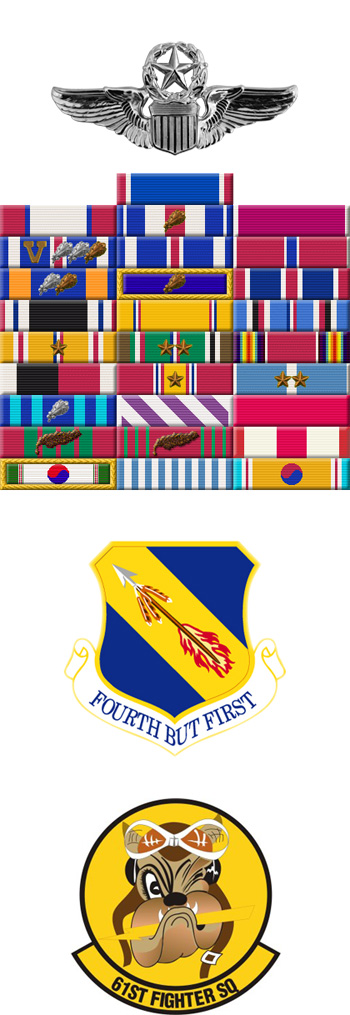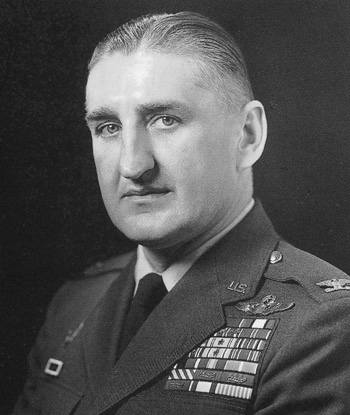
|
Francis S. Gabreski |
 |
|||
| Rank, Service | ||||
Colonel O-6, U.S. Air Force |
||||
| Veteran of: | ||||
|
||||
| Tribute: | ||||
Francis Gabreski was born on January 28, 1919, in Oil City, Pennsylvania. He completed two years at Notre Dame University before entering the Aviation Cadet Program of the U.S. Army Air Corps. Gabreski was commissioned a 2Lt and awarded his pilot wings on March 15, 1941. His first assignment was flying P-36 Hawks and P-40 Warhawks with the 45th Pursuit Squadron of the 15th Pursuit Group at Wheeler Field, Hawaii. He was at Wheeler when Pearl Harbor was attacked on December 7, 1941, and managed to get airborne but the Japanese had withdrawn before he could engage any of their aircraft. Gabreski served with the 45th PS until September 1942, when he became a liaison officer to the 315th Polish Fighter Squadron flying with the Royal Air Force. He flew 20 combat missions in Spitfire Mark IX fighters before joining 61st Fighter Squadron of the 56th Fighter Group in February 1943, flying P-47 Thunderbolts. He took command of the 61st FS in June 1943 and was credited with destroying 28 enemy aircraft in aerial combat plus an additional 3 on the ground before crash landing in Germany and being taken as a Prisoner of War on July 25, 1944. He was held in captivity until being liberated by the Russians in April 1945. Following WWII, Gabreski became Chief of the Fighter Test Section at Wright Field, Ohio, and completed Engineering Flight Test School. He left active duty in April 1946 to work for Douglas Aircraft, but returned in April 1947 and took command of the 55th Fighter Squadron, 20th Fighter Group, at Shaw AFB, South Carolina. Gabreski next went to school at Columbia University, graduating with a BA in Political Science in June 1949. He was next assigned as Commander of the 56th Fighter Group, flying F-80 Shooting Stars and F-86 Sabres at Selfridge AFB, Michigan. In June 1951, Col Gabreski joined the 4th Fighter Interceptor Group at Kimpo AB, South Korea, and immediately began flying combat missions. He took command of the 51st Fighter Interceptor Wing at Suwon AB, South Korea, in November 1951, and was credited with 6.5 more aerial victories in Korea. Gabreski left Korea in June 1952 and served in the Inspector General's Office at Norton AFB, California, from July 1952 to June 1954. He next went through Air War College at Maxwell AFB, Alabama, graduating in July 1955. Gabreski became Deputy Chief of Staff, Headquarters Ninth Air Force at Shaw AFB, South Carolina, in July 1955 and served until August 1956, when he became Commander of the 354th Tactical Fighter Wing at Myrtle Beach AFB, South Carolina. In August 1960, Col Gabreski was assigned as Commander of the 18th Tactical Fighter Wing at Kadena AB, Okinawa, where he served until June 1962. He was Director of the Secretariat at Headquarters Pacific Air Forces at Hickam AFB, Hawaii, from July 1962 to July 1963, and Inspector General of PACAF from July 1963 to August 1964. His final assignment was as Commander of the 52nd Fighter Wing at Suffolk County AFB, New York, from August 1964 until his retirement from the Air Force on November 1, 1967. Col Gabreski wears Command Pilot Wings and accumulated over 5,000 flying hours in his Air Force career. He was also credited with destroying 34.5 enemy aircraft in aerial combat in 289 total combat missions in two wars. After his retirement, Gabreski worked for Grumman Aerospace and the Long Island Rail Road. He married Kay Cochran on June 11, 1945, and they had nine children. Kay died in an automobile accident on August 6, 1993, and Francis Gabreski died on January 31, 2002. They are both buried at Calverton National Cemetery, New York. |
||||
|
||||

